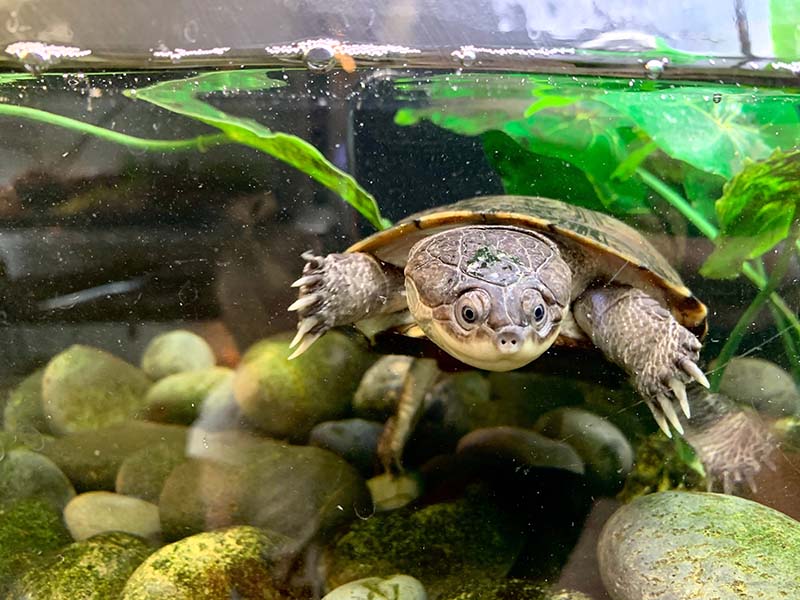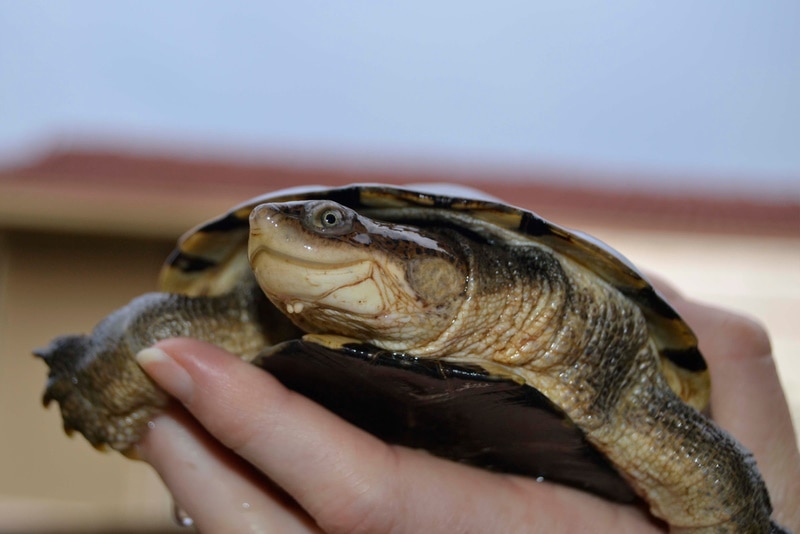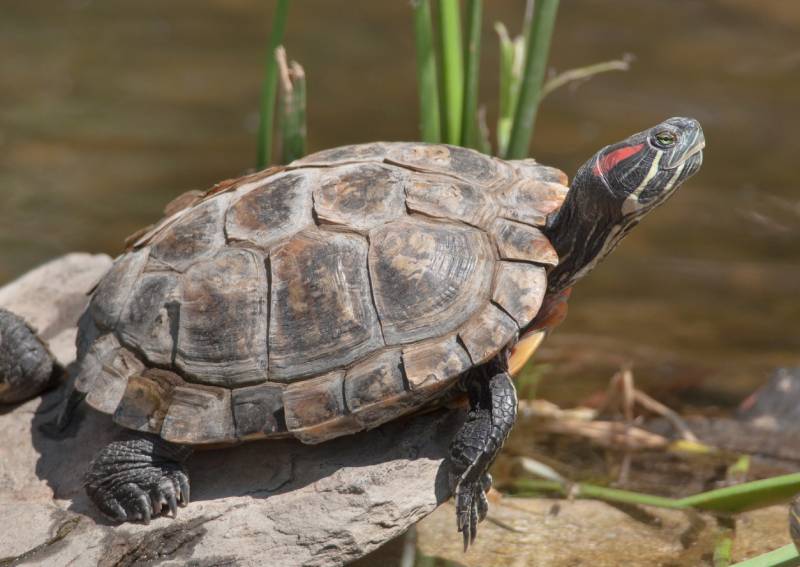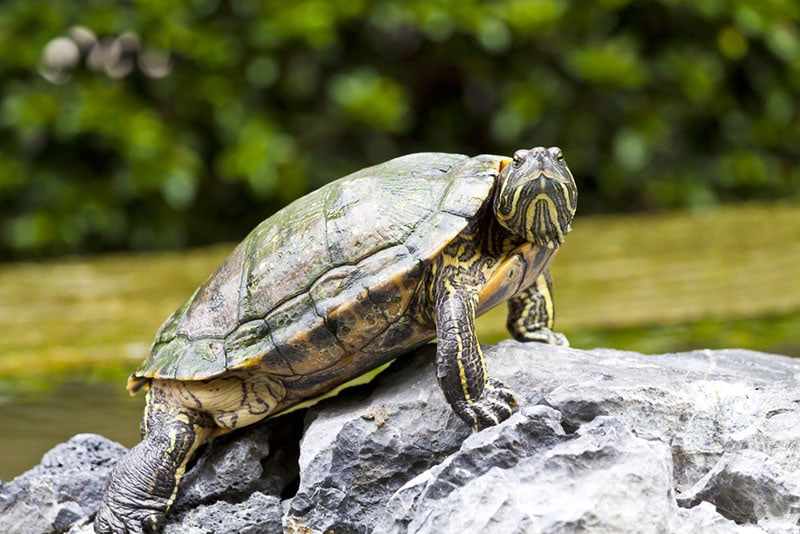African Sideneck Turtle: Pictures, Facts, Diet & Care Guide
By Jordyn Alger
Updated on

The African Sideneck turtle is adored by many turtle owners due to their unique appearance. The interesting shape of the African Sideneck turtle’s mouth makes it seem like they are perpetually smiling. If you’ve had your eye on the African Sideneck turtle for a while and are considering one as a pet, keep reading below to learn more about them.
| Size: | 7–12 inches |
| Weight: | 1.5 pounds |
| Lifespan: | 20 years |
| Suitable for: | Owners who want an entertaining turtle, households with multiple African Sideneck turtles, first-time turtle owners, experienced turtle owners |
| Temperament: | Hardy, active, curious, and undemanding |
The African Sideneck turtle has a brown shell with olive-brown skin. They have black markings on their heads and round eyes that many find charming. Unlike many other turtles, they tuck their head into their side rather than tucking it into their shell. The African Sideneck turtle may be the perfect fit if you want a unique pet.
They have moderate care needs, making them great for still-learning beginners and practiced owners. Before deciding to adopt an African Sideneck, make sure that you take an in-depth look at their care needs through this article. These turtles can live for decades, so they are a long-term commitment.
African Sideneck Turtle Characteristics
How Much Do These Turtles Cost?
The African Sideneck turtle originates from several countries in the western part of Africa. They have been found in Angola, Guinea, Liberia, and Senegal, but they have also been spotted in the Congo in Central Africa and Madagascar. Seychelles (a chain of small islands in the Indian Ocean) and Yemen also report the presence of African Sideneck turtles.
They live in rivers, ponds, and lakes since they are semi-aquatic and live in freshwater habitats. Typically, the African Sideneck turtle thrives in still bodies of water, especially ones with muddy bottoms and a strong vegetation presence.
The African Sideneck turtle isn’t usually too difficult to find and is relatively popular. Reach out to your local pet store and see if they have an African Sideneck turtle available to take home. If they do, you can expect to pay an average of $50–$100 for your pet.
Before purchasing a turtle, ensure you have the resources to cover the upfront expenses. This includes a suitable tank, water, filtration, food, lighting, heating, and more. These expenses can quickly add up, so you may need to save money before bringing your African Sideneck turtle home.

African Sideneck Turtle Behavior
Many people find the African Sideneck to be highly entertaining. At first, they may be a bit shy, but eventually, they will warm up to you. These little creatures are curious and active and are a delight to observe. They are relatively simple to care for and have undemanding natures, making them excellent pets for new and experienced turtle owners.
The African Sideneck turtle’s curiosity can sometimes get them into trouble. Their curiosity can become so intense that it verges on aggression. They can also become aggressive with other African Sideneck turtles; however, this occurs most often when eating or mating. Likewise, their aggression may be due to their living conditions being suboptimal. Even so, the African Sideneck turtle is not known to be especially aggressive with humans.
The only time an African Sideneck turtle may behave aggressively toward a human is if they are being mishandled. Poor handling can frighten and even hurt the African Sideneck turtle, and they may lash out as a result. Therefore, inexperienced turtle owners are discouraged from handling the African Sideneck turtle too often until they’ve mastered the proper technique.
Do These Turtles Make Good Pets?
The African Sideneck turtle is an excellent pet. They are entertaining, curious, and undemanding, so many turtle owners enjoy having these turtles around. As mentioned before, the African Sideneck turtle can sometimes display aggression toward people, but that is mainly due to poor handling.
African Sideneck Turtle Breed Tank Mates
These turtles can get along well with other African Sideneck turtles. Multiple African Sideneck turtles can be housed together; however, you shouldn’t do it if you aren’t prepared for a clutch of eggs to appear.
African Sideneck turtles can live with other turtle species, and some have been known to live with larger fish. However, be careful about housing the African Sideneck turtle with small fish; small fish are part of a turtle’s regular diet.
Your African Sideneck turtle should never be introduced to dogs, cats, or other larger animals. Introducing these animals can place significant stress on your African Sideneck turtle, leading to illness.
Care Sheet & Habitat Setup:
Light Requirements
African Sideneck turtles require a UVB light that stays on a cycle of 12 hours. This 12-hour cycle mimics the shift between day and night, which helps your turtle receive a proper amount of UVB and vitamin D. As a result, your African Sideneck turtle can properly synthesize calcium.

Tank Size
As an aquatic turtle, the African Sideneck turtle requires water access in their tank. At a minimum, you should provide a tank that holds 75 gallons. Half to three-quarters of this tank should be filled with water. Rectangular tanks are ideal, and the shape provides more room for your turtle to swim. If the tank is too long and narrow, your turtle won’t have as much space to move around.
Make sure there is an area in your tank for dry land. The African Sideneck turtle needs space to bask and dry off after a swim; without it, they won’t be able to regulate their body temperature properly.
If you plan to house multiple African Sideneck turtles together, you must provide an even larger tank to ensure they do not feel threatened by each other’s presence.
Water Temperature
Monitoring the temperature of the water is an essential part of caring for your turtle. For the African Sideneck turtle, a proper aquatic temperature range is between 70° and 75° Fahrenheit.

Plants
Decorating your turtle’s enclosure is vital for their mental stimulation and enjoyment. Using decorations to mimic your African Sideneck turtle’s natural habitat is a great way to make them feel at home. Plastic plants, driftwood, and rocks are good choices for spicing up the enclosure; just be sure to avoid rocks with sharp edges or rocks that are small enough for your turtle to swallow.
African Sideneck turtles need places to burrow or rest beneath, so provide a shady spot for your pet beneath driftwood or a hidey-hole. As for plants, a mixture of artificial and live plants is fine for your pet. The African Sideneck turtle will enjoy an abundance of vegetation, so don’t neglect to fill their tank with plants.
Substrate
Large pieces of pebble or gravel can make excellent substrates for the aquatic parts of your African Sideneck turtle’s tank. For the land portion, sand is a perfectly natural choice. Again, avoid substrates with sharp edges, which may harm your turtle.
Filtration
Filtration is essential to ensuring the quality of your turtle’s environment and health. A filter with a flow rate of around 350 gallons per hour is adequate for the African Sideneck turtle’s tank. In addition to proper filtering, make sure that you change the water in your pet’s tank frequently. Changing it every few days or so is a good guideline to follow.
Things to Know When Owning an African Sideneck Turtle:
If you think that you can care for the African Sideneck turtle, there are a few more things you should know before you make the commitment. In addition to your turtle’s habitat care, you also need to meet their food and diet requirements. Furthermore, you will need to be aware of the proper size of an African Sideneck turtle and the average lifespan and common health conditions to watch out for.
Food & Diet Requirements
The African Sideneck is an omnivore in the wild and is designed to eat plant and animal materials. Your turtle will happily munch on the plants, insects, and fish they encounter. Since they will eat nearly anything they come across, it is your job to ensure your pet receives a balanced diet. A variety of foods is vital to your turtle’s health and well-being.
While your turtle is still growing, they will eat mainly insects. However, as they mature, their diet will shift to plant-based materials. Some plants you can feed your African Sideneck turtle include spinach, romaine, and red-leaf lettuce. Collard greens, dandelions, and mixed vegetables are also good options.
As for animal-based materials, focus on earthworms, clams, snails, fish, and aquatic insects. You can also feed your turtle plain-cooked chicken, plain-cooked beef hearts, crustaceans, and small amphibians.

Size & Growth Chart
Typically, the female African Sideneck turtle is larger than the male. Female African Sideneck turtles grow to be around 7–12 inches, whereas the males grow to around 7–10 inches. Females also have longer shell bodies than males, which is why they tend to grow larger.
Lifespan and Health Conditions
On average, the African Sideneck turtle can live 20 years. In the wild, the African Sideneck turtle has been observed living for as long as 30 years. Some reports suggest that this turtle can live as much as 50 years in captivity. Caring for this pet is a lifetime commitment, so make sure you are up to the task before you bring one home.
Some of the most common health conditions the African Sideneck turtle experiences include dehydration, malnutrition, and parasites. These issues can be largely avoided if you monitor your turtle’s food and water intake and keep their enclosure in good condition. If your turtle is experiencing any of these conditions and you are unsure why, reach out to your vet immediately.
- Parasites
- Dehydration
- Malnutrition
Male vs Female
Be wary of keeping males and females together since they may reproduce. You can determine if your African Sideneck turtle is sexually active by knowing their age. If you have a male African Sideneck turtle, he will be sexually mature when he reaches 3–5 years of age. As for a female, she will reach sexual maturity around 5–7 years old.

3 Little-Known Facts About African Sideneck Turtle
1. Currently, There Are Not Any Officially Recognized Subspecies of the African Sideneck Turtle.
2. Since the African Sideneck Turtle Is Similar to the African Helmeted Turtle, Their Names Are Often Interchanged.
3. Another Name for the African Sideneck Turtle Is the West African Mud Turtle.
Final Thoughts
The African Sideneck turtle is a unique pet that’s suitable for first-time owners and experienced ones. If you are one of the many who have been lured in by this magnificent turtle, make sure that you can provide everything listed in this article before bringing the African Sideneck turtle home. In addition, consult your vet to ensure you are providing the best level of care for your pet that you possibly can.
Featured Image Credit: Megan Czarnocki, Shutterstock











